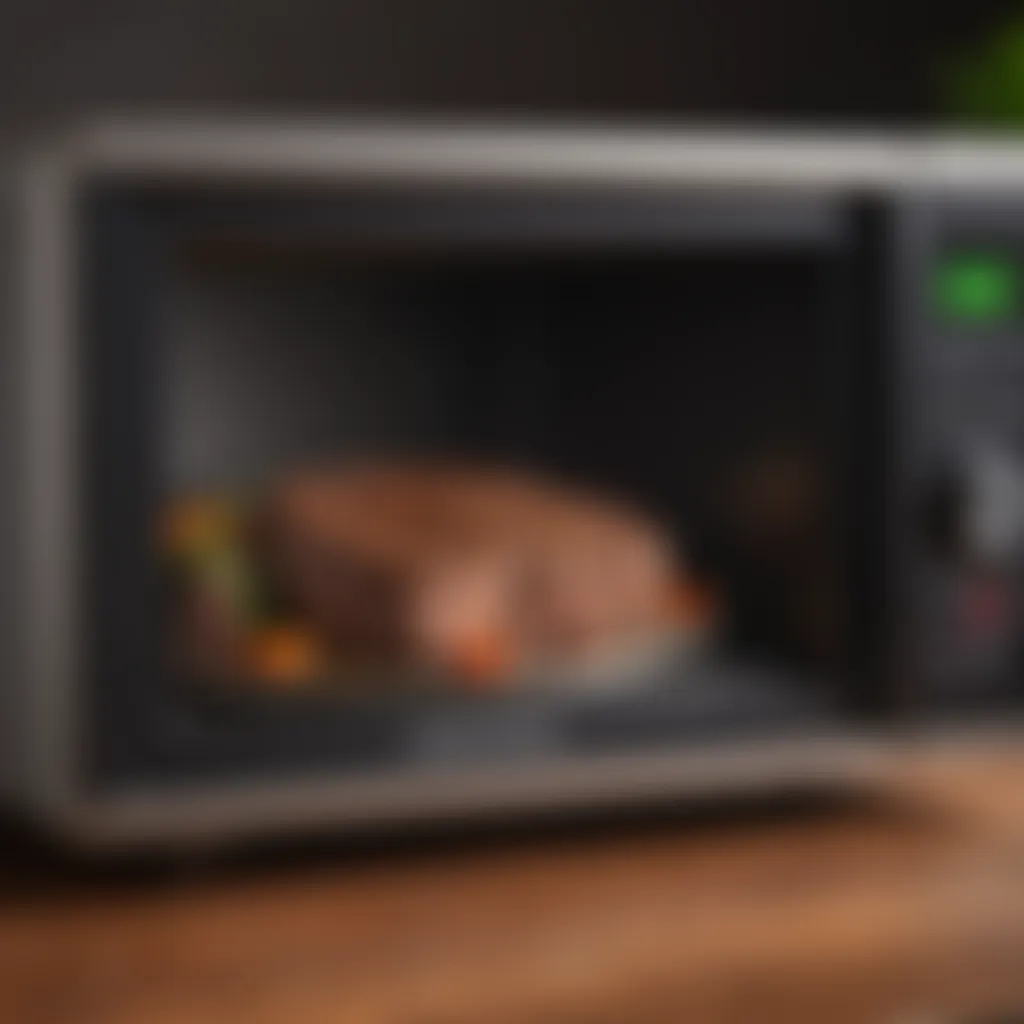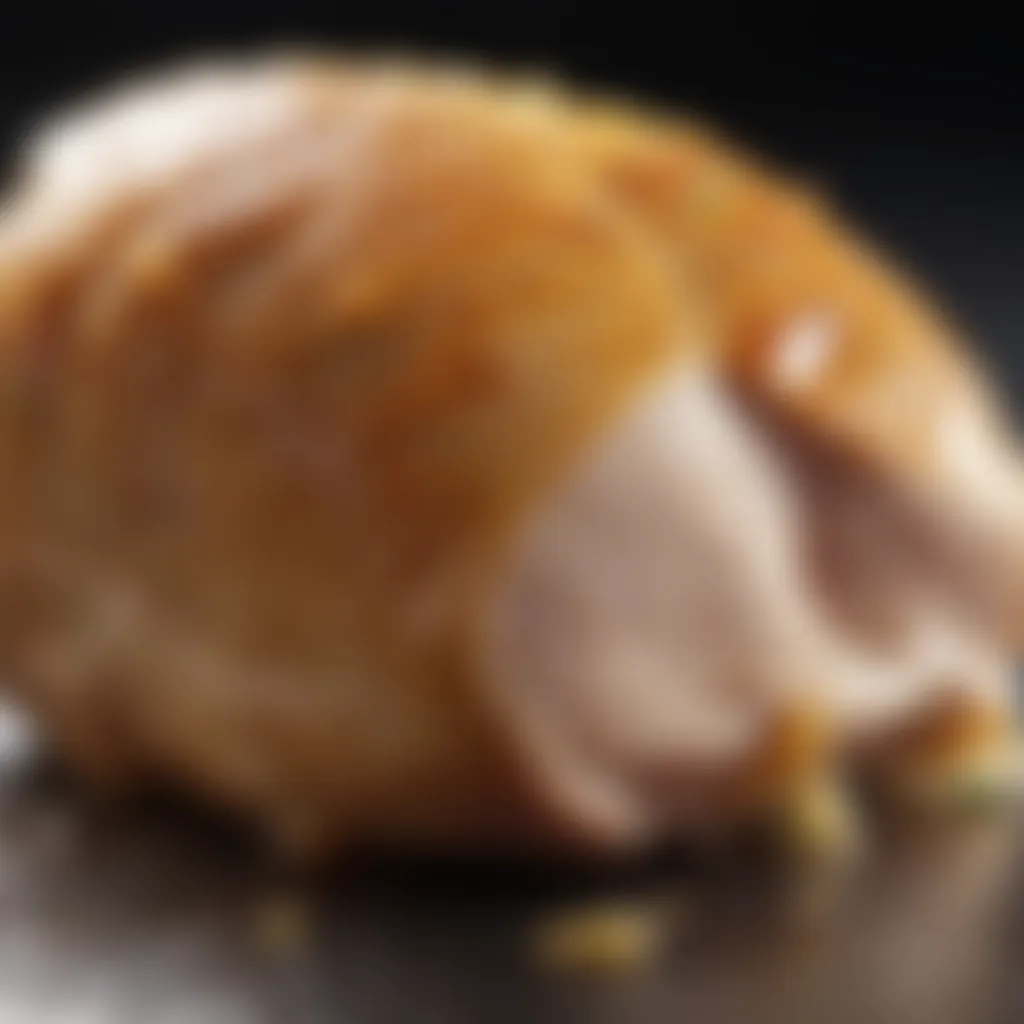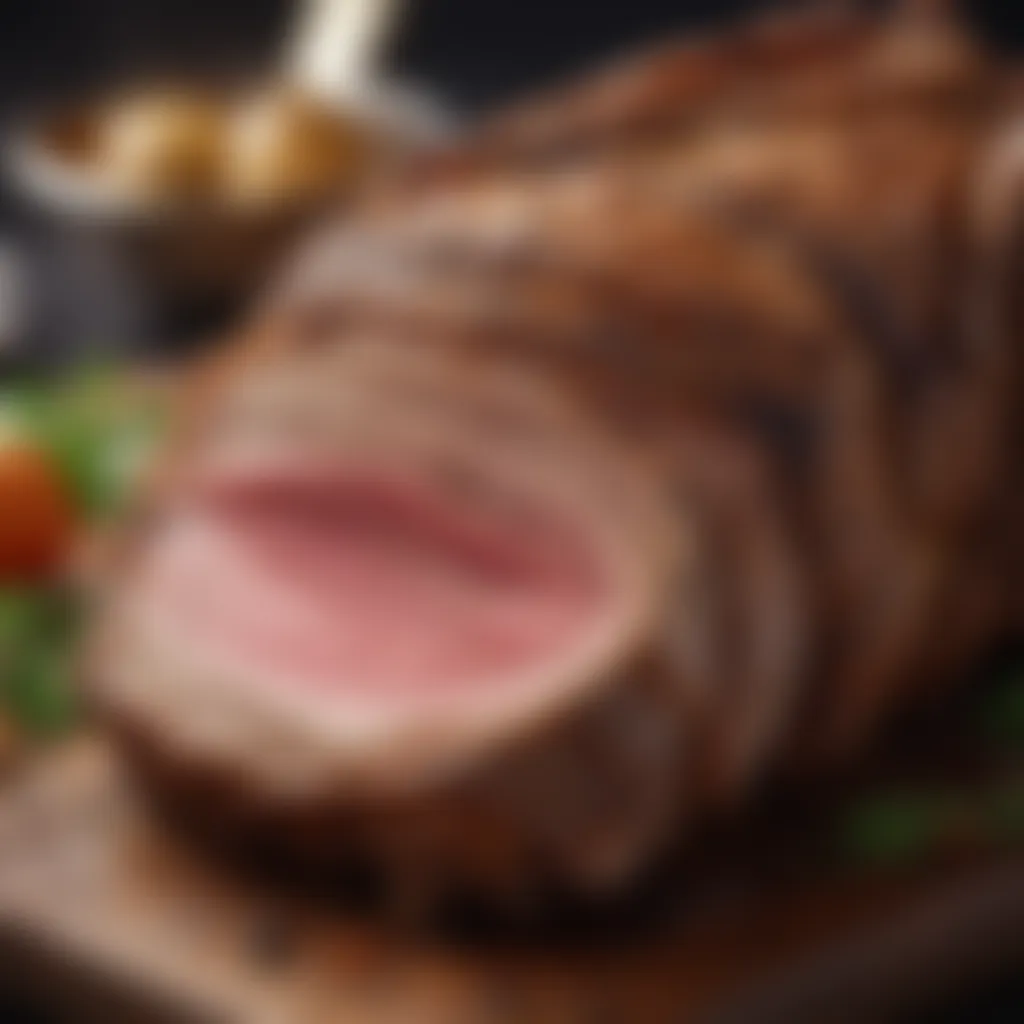Mastering Microwave Meat Cooking Techniques


Intro
Microwave cooking is often misunderstood, especially when it comes to preparing meat. Many people dismiss this method as inferior or inefficient. However, when done correctly, cooking meat in the microwave can yield delicious results. Understanding how to effectively use this appliance can save time without sacrificing quality. In this guide, we aim to uncover the essential components of microwave meat cooking, outlining the ingredients needed, preparation steps, technical aspects, and the entire cooking process.
Ingredients:
When embarking on a microwave cooking adventure, having the right ingredients is crucial. Here is a comprehensive list:
- Meat (choose one):
- Seasoning:
- Olive oil or butter:
- 1 lb of chicken breast or thighs
- 1 lb of beef steak (sirloin or ribeye)
- 1 lb of pork chops
- 1 teaspoon of salt
- 1/2 teaspoon of pepper
- 1 teaspoon of garlic powder
- 1 teaspoon of onion powder
- Optional herbs: rosemary or thyme
- 1 tablespoon to drizzle or spread on the meat
Detailed Instructions:
Step 1: Preparation of Ingredients
- Selecting the Meat:
Choose one type of meat from the list. Ensure it is fresh or properly thawed if frozen. - Seasoning:
Rub the salt, pepper, garlic powder, and onion powder evenly across the surface of the meat. Sprinkle fresh herbs if desired. This enhances flavor. - Applying Fat:
Drizzle olive oil or spread butter on the meat. This will help retain moisture during cooking.
Step 2: Setting Up the Microwave
- Place a microwave-safe plate or dish at the bottom of the microwave.
- Ensure the turntable is clean and functioning.
Technical Aspects:
Understanding temperature settings and timing is key to achieving well-cooked meat.
- Temperature Settings:
- Timing Specifics:
- Usually, the highest setting (1000 watts or more) is ideal for most types of meat.
- Chicken: cook for about 6-8 minutes per pound.
- Beef: cook for about 5-7 minutes per pound.
- Pork: cook for about 7-9 minutes per pound.
Critical Techniques:
- Ensure to rotate the meat halfway through cooking for even heat distribution.
- Let the meat rest for a few minutes after cooking to allow juices to settle.
Sequential Steps of Cooking Process:
- Initial Cooking:
Place the seasoned meat in the microwave. Cover with a microwave-safe lid or wrap with microwave-safe plastic wrap to trap steam. - Middle Cooking:
After the initial cooking time (half of your calculated time), pause the microwave, carefully rotate or flip the meat. - Final Cooking:
Resume cooking for the remaining time. Use a meat thermometer if available. Chicken should reach an internal temperature of 165°F, beef should hit at least 145°F, and pork should reach 145°F as well.
Troubleshooting Tips:
- Common Mistakes:
- Adjustments:
If the meat is not fully cooked, add 1-2 minutes and recheck. Always cover in case of continued cooking to keep moisture in.
- Overcooking leads to dry meat. Check doneness periodically.
- Not seasoning adequately results in bland flavor.
"The art of microwave cooking lies in precision and understanding each step of the process."
This guide aims to empower you with knowledge, making your microwave a versatile tool in the kitchen.
Preamble to Microwave Cooking
Microwave cooking has transformed how we approach food preparation. It is fast and efficient, making it suitable for busy lifestyles. For homemakers, understanding this technique is crucial. It allows for optimal meal planning while embracing new culinary horizons. This guide focuses on the intricacies of cooking meat in the microwave, covering not only methods but also safety and flavor profiles.


Navigating the nuances of microwave cooking helps in maximizing taste while reducing cooking times. Many people still hold reservations about using a microwave, often due to misconceptions about its effectiveness. Focusing on cooking meat reveals how this appliance can provide both convenience and quality.
Understanding Microwave Energy
Microwave energy works by agitating water molecules in food. This agitation generates heat, allowing the food to cook evenly. In the case of meat, the distribution of heat is key to maintaining texture and juiciness. Microwaves penetrate about one inch into meat, causing the moisture within to heat up and naturally steam the surrounding layers. It reduces cooking time significantly compared to traditional ovens, which rely on convection heat.
The effectiveness of microwave energy varies with the size and shape of the meat. Thinner cuts cook faster than larger ones. Moreover, it's important to consider how microwave power settings can impact cooking results. Understanding these elements helps in utilizing the microwave safely and efficiently.
The Evolution of Microwave Technology
Microwave ovens have come a long way since their inception in the mid-20th century. Originally designed for industrial use, they became household staples in the 1970s. The technology improved dramatically over the decades, leading to various features such as pre-programmed settings and sensor cooking.
Modern microwaves are equipped with advanced controls that allow for precise calculations of cooking times. This improves both efficiency and effectiveness. Different brands like Panasonic, Samsung, and LG have focused on user-friendly designs that promote ease of use in daily cooking scenarios. Innovations in inverter technology and grill microwave models have also enhanced cooking capabilities. This evolution is crucial for homemakers, as it allows more flexibility and control over the cooking process.
The Science Behind Cooking Meat
Understanding the science behind cooking meat in the microwave is essential for achieving optimal results. The microwave does not just heat food; it cooks it through precise interactions at the molecular level. Knowing how meat reacts to microwave energy can influence flavor, texture, and overall quality.
Microwave cooking differs significantly from conventional methods. The focus is on how heat is generated within the meat, affecting cooking time and efficiency. This section breaks down critical elements, helping you navigate the complexities of microwave cooking with confidence.
Thermal Conductivity in Meat
Thermal conductivity is a measure of how well heat moves through a material. In the context of meat, this affects how quickly and evenly cooking occurs. Meat is mainly composed of water, proteins, and fats. Water has a high thermal conductivity, so it heats up rapidly in a microwave. This can lead to uneven cooking, particularly in thicker cuts. To overcome this, it’s beneficial to cut meat into smaller pieces or use techniques such as rotating or rearranging during cooking.
Additionally, understanding the placement of meat in the microwave can also enhance cooking efficiency. For instance, positioning meat near the outer edges of the microwave allows for more even exposure to the microwaves, helping to mitigate the risk of cold spots.
Microwave Interactions with Meat Proteins
When microwaved, meat proteins undergo a series of transformations. The energy from microwaves causes molecular vibrations within the meat proteins, leading to changes in texture and firmness. It should be noted that different types of proteins react differently to heat. Fibrous proteins in tougher cuts require more time to break down, while tender cuts may become overcooked quickly.
Microwaving essentially denatures proteins, which means that their structure is altered. This denaturation is key for cooking, as it helps the meat reach palatable textures. However, it can also make the meat rubbery if overcooked. This highlights the importance of monitoring cooking times and using appropriate settings.
Tip: Use a meat thermometer to check doneness more accurately. This can help prevent the common mistake of undercooking or overcooking meat in the microwave.
Types of Meat Suitable for Microwave Cooking
Cooking meat in the microwave can be an effective way to save time while still enjoying flavorful meals. However, not all types of meat respond equally well to this cooking method. Understanding the specific elements, benefits, and considerations related to different types of meat is crucial for achieving the best outcomes. This section delves into the variety of meats that can be cooked in the microwave, addressing their individual characteristics, necessary cooking techniques, and common pitfalls.
Poultry and Microwave Cooking
Poultry, including chicken and turkey, is often favored for microwave cooking. One of its advantages is that it cooks relatively quickly, making it ideal for busy households. When cooking poultry, it is essential to ensure even cooking throughout. This can be achieved by cutting larger pieces into smaller, uniform sizes. The USDA recommends that poultry should reach an internal temperature of 165°F (74°C) to ensure safety. Thawing is another significant aspect. Always thaw poultry in the refrigerator or use the microwave’s defrost setting. When cooking, consider covering the meat to retain moisture, preventing it from drying out.
Beef Considerations in the Microwave
Beef can be tricky when cooked in the microwave. Its texture can become tough if overcooked, often leading to unsatisfactory results. Cuts like ground beef and thin steaks tend to work better in microwaves. Thicker cuts require more careful attention to avoid uneven cooking. Utilizing a meat thermometer is advisable to check internal temperatures, which varies based on cooking preferences. For safety, ground beef should reach 160°F (71°C). Microwaving beef in smaller portions can enhance even cooking and tenderness.
Pork and Microwave Efficiency
Microwaving pork is straightforward, but certain cuts yield better results. Pork chops, roasts, and tenderloins are suitable options, provided they are of uniform thickness. The moisture level is vital, as pork can dry out quickly. To maintain juiciness, it can be beneficial to add a little bit of water or broth to the cooking dish. The recommended internal temperature for pork is 145°F (63°C), with a resting time to allow juices to redistribute. This resting phase is critical for ensuring a pleasant eating experience.
Seafood: Timing and Techniques
Seafood generally cooks quickly in the microwave, making it a convenient choice. Fish fillets and shrimp are particularly well-suited to this method. When cooking seafood, time it carefully; overcooked fish becomes tough and dry. Unlike other meats, seafood tends to be done when it is opaque and flakes easily with a fork. A guideline is to cook fish for approximately 3-5 minutes per pound, depending on its thickness. Always keep an eye on cooking progress, especially when using high wattage microwaves in order to achieve optimal texture.
"Choosing the right type of meat not only influences cooking time but also affects flavor and texture significantly."
Preparing Meat for Microwave Cooking
Preparing meat correctly before microwaving plays a vital role in achieving both safe and flavorful results. A common mistake is underestimating how prep can impact texture, taste, and safety. This section highlights techniques to ensure that meat is ready for the unique environment of the microwave.


Thawing Meat Safely
Thawing is a crucial first step when working with frozen meat. It is important to do this correctly to prevent any foodborne illnesses. When meat is thawed improperly, bacteria can thrive. The safest method involves using the microwave itself if one needs to go quickly.
- Place the frozen meat in a microwave-safe dish.
- Use the ‘defrost’ setting on the microwave. This function helps to evenly distribute the energy, reducing the risk of cooking the edges while the center remains frozen.
- Make sure to rotate the meat periodically if the microwave doesn’t have a turntable. This ensures that all sides thaw evenly.
Always aim to cook meat immediately after thawing. Bacteria multiply quickly at temperatures above 40°F (4°C). Therefore, it’s best to limit the time thawed meat sits at room temperature.
Marinating Techniques for Flavor
Marinating meat before microwaving enhances its flavor and tenderness. This technique infuses the meat with various tastes while also helping to break down tougher fibers. Here are a few approaches to consider:
- Use a Ziploc bag: This allows for even distribution of the marinade while minimizing the amount of liquid needed.
- Short marination times: For most meats, even 30 minutes can be sufficient. Poultry like chicken tends to soak up flavors quickly. Beef and pork might benefit from longer marinating times, but be cautious not to overpower the natural taste.
- Consider acidic ingredients: Ingredients like vinegar, lemon juice, or yogurt can tenderize the meat. However, avoid marinating in acids for too long, as this can lead to a mushy texture.
It’s also worth noting that a marinade can serve as a sauce. Saving a portion of the marinade (before it touches raw meat) can provide a rich flavor boost during serving.
Taking time to properly prepare meat is key for both delicious flavors and safety.
Microwave Cooking Techniques
Microwave cooking has garnered a place in modern kitchens for its convenience and efficiency. Understanding the techniques related to microwave cooking is crucial, especially when preparing meat. This section examines specific methods that maximize flavor and maintain texture while ensuring safety.
Choosing the Right Microwave Settings
Choosing the right settings on your microwave can significantly affect the meat's cooking outcome. Each microwave has different wattages, and understanding your appliance is essential.
- Power Level: Cooking meat often requires low to medium power settings. High power can lead to dry or unevenly cooked meat. For instance, using a medium setting is advisable for poultry to ensure thorough cooking without toughening.
- Time Management: Set timers with precision. It is better to start with shorter cooking periods, adding time incrementally. This minimizes the risk of overcooking and losing moisture. You might find it beneficial to use a thermometer to gauge doneness accurately.
"Proper timing and power setting are the keys for juicy and well-cooked meat in the microwave."
Covering and Ventilation Strategies
Another vital aspect of microwave cooking is how you cover the meat and manage ventilation. Covering meat helps retain moisture and ensures even cooking. The following considerations should be taken into account:
- Using Microwave Covers: A microwave-safe lid or plastic wrap can trap steam. This moisture helps cook the meat evenly. However, ensure that the cover allows for some steam escape to avoid pressure build-up that could lead to splattering.
- Ventilation: If using plastic wrap, make sure you leave a small part uncovered. This allows steam to escape safely. In contrast, if you use glass covers, ensure they have a vent or partially lift one edge. This approach is helpful for thicker cuts of meat.
Using Microwave-Safe Cookware
The type of cookware you select can influence cooking results significantly. Not all materials are safe for microwave use, and some can react poorly under high heat. Here are some types of cookware to consider:
- Glass and Ceramic: Both materials are generally safe and great for microwave cooking. They do not leach substances into food like some plastics might. Whenever possible, opt for glass containers designed for microwave use.
- Plastic Containers: Ensure they are labeled microwave-safe. Some plastics can warp or melt, which poses safety risks. Avoid using old or scratched plastic containers, as they may release harmful chemicals.
- Avoid Metal Cookware: Metal can create sparks and cause damage to the microwave. Always opt for non-metal containers when reheating or cooking meat.
By adopting these techniques and understanding how each element impacts the process, you can achieve optimal cooking results with your microwave. Paying attention to settings, covering strategies, and cookware safety can lead to delightful and hassle-free meal preparation.
Monitoring Cooking Progress
Monitoring cooking progress is essential when cooking meat in the microwave. This process ensures that the meat is cooked thoroughly, minimizing the risk of undercooking or overcooking. Such risks not only compromise flavor but also affect safety. Proper oversight allows you to adjust cooking time and settings, ensuring even texture and juiciness. Microwave cooking can produce uneven results due to the nature of microwave energy. Thus, developing skills to monitor progress is crucial for success.
Meat Temperature Guidance
Understanding the correct internal temperature of meat is vital. Each type of meat has different safe cooking temperatures, ensuring that harmful bacteria are eliminated. For instance, poultry such as chicken and turkey should reach a minimum internal temperature of 165°F (74°C). Ground meats like beef or pork should reach 160°F (71°C). Other cuts of beef can be safely consumed at 145°F (63°C) after resting.
To effectively monitor temperature, using a food thermometer is recommended. This tool gives precise readings and helps avoid guessing. Insert the thermometer into the thickest part of the meat, avoiding bones, as they can give false readings.
Tip: Allow a few minutes of rest after microwaving. The temperature can rise as the meat continues to cook internally.
Resting Time: Importance and Impact


Resting time plays a significant role in meat cooking. After removing the meat from the microwave, give it a chance to rest for several minutes. This waiting period allows the juices to redistribute throughout the meat, improving flavor and maintaining moisture.
The impact of resting time should not be underestimated. If you cut into meat immediately after cooking, the juices will likely escape. This results in drier meat. For example, resting a chicken breast for about five minutes can lead to a noticeably juicier result compared to cutting without resting.
It’s simple: longer rest times lead to better flavor retention. Thus, incorporating this practice into microwave cooking can improve outcomes significantly. This knowledge equips cooks for enhanced flavor profiles and overall satisfaction during meal times.
Common Myths and Misconceptions
In the context of cooking meat in the microwave, there are numerous myths and misconceptions that can lead to confusion. It is critical to debunk these myths to maximize the benefits of this technique. Misunderstandings around microwave cooking can affect both safety and the overall outcome of meat products. This section will attempt to clarify some of the most prevalent myths, thus enabling housewives and cooks of all skill levels to enjoy flavorful and safe meals.
Nutritive Value Implications
One of the most common myths surrounding microwave cooking is that it diminishes the nutritive value of food. Some people believe that microwaving meat causes a significant loss of nutrients. However, the reality is quite the opposite. Studies have shown that the cooking time in a microwave is generally shorter than other cooking methods. Shorter cooking times can actually help in preserving vitamins and minerals.
Microwave cooking can help keep nutrient levels intact, especially if proper techniques are employed. For instance, not overcooking and keeping the meat covered can minimize nutrient loss. In addition, research has demonstrated that micronutrient retention is often better in microwave cooking than boiling, which can leach nutrients into the water used. Moreover, many users prefer microwaved meat for its tenderness and flavor, which can further encourage nutritious meal creation.
Flavor Preservation and Enhancement
Another misconception is that microwaved meat lacks flavor compared to other cooking methods. This belief often stems from experiences with improperly cooked or prepared meat. When done correctly, microwaving can actually enhance flavor rather than diminish it. The key is to focus on proper seasoning and marination prior to cooking.
Using marinades or spices before microwaving can enhance the overall taste significantly. Also, covering the meat while microwaving helps trap steam, preventing it from drying out and preserving the juicy texture. In some cases, the microwave can lock in flavors more effectively since the cooking environment is confined.
Safety Considerations
Cooking meat in the microwave presents unique safety considerations that deserve thoughtful attention. Understanding these aspects helps ensure not only the quality of the finished dish but also the health of those consuming it. Several specific elements influence the safety when using a microwave for cooking meat. This includes understanding uneven cooking, proper storage, and reheating methods.
Uneven cooking can result in meat that is undercooked in some areas. This poses health risks, especially with poultry and pork, which can harbor harmful bacteria if not cooked thoroughly. Additionally, proper storage is essential for maintaining the quality and safety of meat before it even reaches the microwave. Understanding the nuances of reheating also plays a critical role. Improper methods can allow bacteria to flourish, thus negating any precautions taken during initial cooking.
Overall, recognizing these safety considerations can enhance both the enjoyment of the meal and the well-being of those who partake in it.
"Proper attention to safety can transform microwave meat cooking from a convenience into a culinary triumph."
Avoiding Uneven Cooking and Cold Spots
One of the foremost concerns when microwaving meat is the likelihood of uneven cooking. Unlike conventional cooking methods, microwaves rely on electromagnetic energy to heat food. This energy can create hotspots, resulting in some areas cooking faster than others. This is particularly troublesome in thicker cuts of meat. To avoid this, first, ensure uniform thickness by cutting meat into evenly sized portions.
It can also be beneficial to rearrange pieces midway through cooking. Stirring, if applicable, aids in promoting a more even heating pattern. Additionally, using microwave-safe covers can help trap steam, which allows heat to distribute more evenly throughout the meat.
Monitoring the temperature with a meat thermometer can indicate if there are any cold spots. Aim for the safe minimum internal temperatures: 165°F for poultry and 145°F for certain cuts of pork. This extra attention will contribute immensely to food safety and the quality of the meal.
Proper Storage and Reheating Methods
To maintain safety and prevent foodborne illnesses, proper storage of meat is crucial, both before microwaving and during reheating. Raw meat should be stored at or below 40°F in the refrigerator, ideally within its original packaging or in a sealed container to prevent contamination. If storing cooked meat, make sure to refrigerate within two hours to limit bacterial growth.
When reheating meat in the microwave, it is imperative to do so thoroughly. Aim for uniform temperatures across the entire piece. Arrange leftover meat in a circular pattern on the plate. This ensures more consistent heating. Cover the dish with a microwave-safe lid or wrap to help retain moisture and prevent drying out.
Allowing for resting time after reheating also allows the heat to equalize, further reducing the chance of cold spots. Adhering to these storage and reheating methods can ensure your family safely enjoys their meals with confidence.
The End
The conclusion of this guide holds significant importance as it wraps up the experience of cooking meat in the microwave. It brings together many aspects covered in the article, emphasizing the practicality and efficiency of this method. One major benefit is the time saved in meal preparation. Many households today seek quick solutions, and microwave cooking provides that amidst busy lifestyles.
Future of Microwave Cooking Techniques
Looking toward the future, microwave cooking techniques are likely to evolve further. Innovations in technology may introduce new microwaves equipped with advanced features such as smart sensors, which can adjust cooking times and power levels automatically. This could lead to better results and eliminate the guesswork often associated with microwave cooking. Additionally, there could be an increasing emphasis on energy efficiency and sustainability in appliance design. As more households focus on energy consumption, the demand for microwaves that are both effective and environmentally friendly will rise.
Final Thoughts on Efficiency and Quality
In concluding thoughts, efficiency and quality stand central in microwave meat cooking. Efficiency comes from understanding the precise cooking times for various meats and employing the right techniques. Quality, however, is achieved through proper thawing, seasoning, and resting times.
To ensure meat remains juicy and flavorful, one must embrace methods like covering meats to retain moisture. \nOverall, the combination of modern techniques and mindful preparation leads to satisfying results. The microwave can serve as a reliable ally in the kitchen, offering the possibility of enjoying excellent meals without compromising on taste or quality.
"Understanding both efficiency and quality enhances the cooking experience and outcome in the microwave."
By embracing these insights drawn from this guide, anyone can master the art of cooking meat in the microwave, turning it into a simple yet sophisticated cooking technique.







